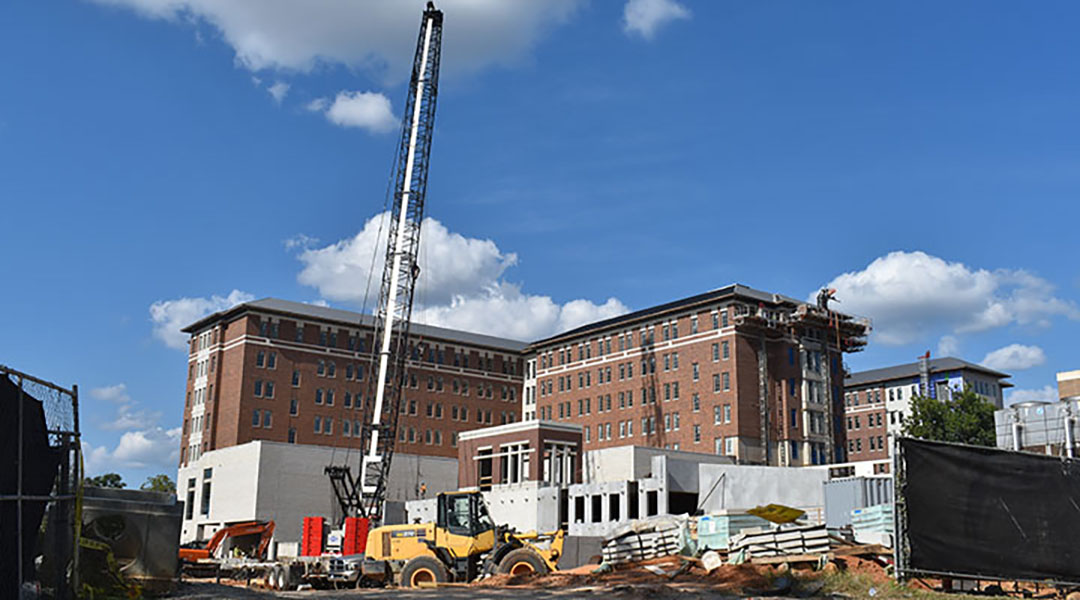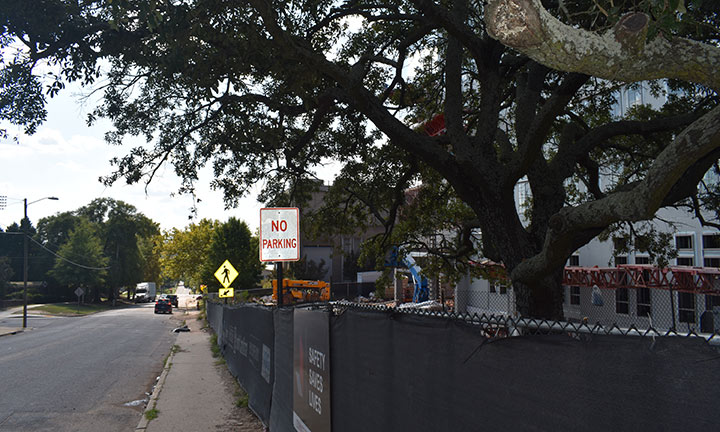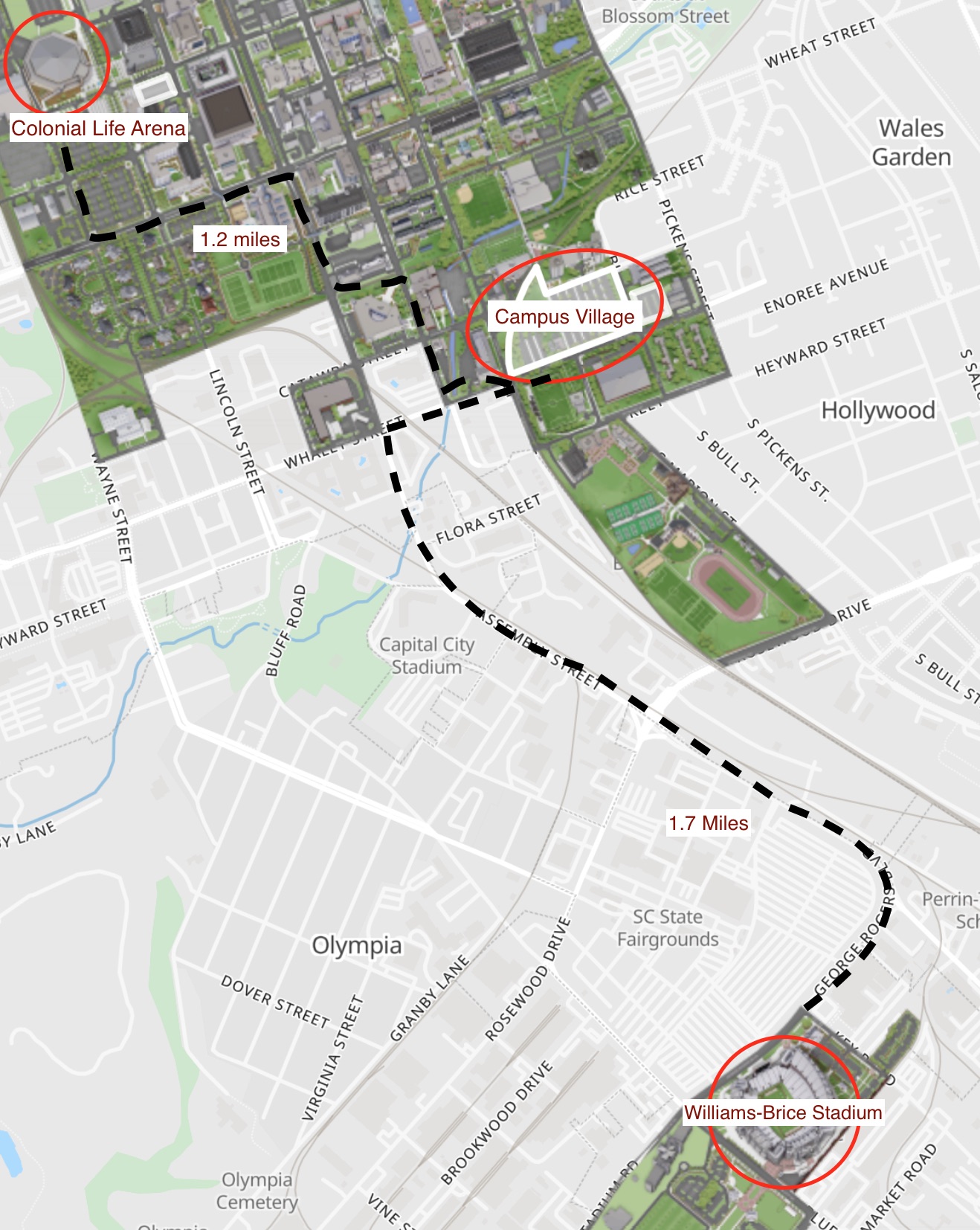Construction is continuing on USC’s south campus, which will include four dorms, a dining facility, a cafe and a ‘transportation hub.’ (Photos by Audrey Elsberry)
USC is building four dorms with nearly 2,000 beds on Whaley Street, but students with cars might have to park almost two miles away – or in surrounding neighborhoods, as homeowners long have feared.
The original plan in 2017 was to have 3,000 parking spots for what’s called the Campus Village. The most recent plan only includes 200 spaces.
Neighbors say the University of South Carolina has a new parking plan but that most of them haven’t seen it. University officials would not confirm there is a new plan, but they know neighbors are unhappy.
Residents of the Wales Garden, Wheeler Hill and Hollywood-Rose Hill neighborhoods would be the most affected.
City councilman and downtown resident Howard Duvall described the current Campus Village parking plan as a “disaster waiting to happen.”
The university is “ruining some of the finest neighborhoods in the city with the unbridled growth of the student population without providing adequate buildings and structures like parking garages for the students,” Duvall said.
Campus Village is the largest construction undertaking in the history of the University of South Carolina and will include a cafe and a dining facility. USC spokesperson Jeff Stensland said all students who will live in Campus Village won’t be able to park there.
The university plans to convert existing remote parking lots into lots for Campus Village residents. This, in turn, will push both Campus Village and commuting students farther from campus, to lots near Williams-Brice Stadium and Colonial Life Arena.
“We’ll have more parking in the fall of 2023 than we currently have,” Stensland said. “We’re going to be opening up additional spaces near Colonial Life Arena in a remote lot.”
Two parking lots near Williams-Brice Stadium are opening as well.
Students “can park their car out in a more remote lot to shuttle into campus or to their, you know, back to Campus Village,” Stensland said.
Some people say the university has broken its agreement with the neighborhoods around the area between Sumter and Pickens streets.
Kit Smith, who lives near the new construction, has been involved for several years with the Campus Village planning.
The initial plan was for three parking garages on-site with 3,000 parking spots, she said. That plan got downsized to one parking garage with 935 parking spots by the time it went before city officials. That was the last plan that was agreed upon between the university and the neighborhoods.
Neighborhoods discovered in early 2021 that USC only planned to include 200 parking spaces and not 900. Residents were not happy.
“This was a big change for us,” Smith said, “and a concern that this would mean we would have more students driving through and parking in our neighborhoods that are adjacent to the south campus.”
Duvall said the university is not being realistic in expecting students to ride shuttles to remote parking lots.
“That’s just not facing the facts,” Duvall said. “The students will not ride a bus or walk a mile, or 2 miles, or 4 miles to get back to campus. They are going to park in the neighborhoods.”
The neighborhoods around Whaley Street have been communicating with the university about their concerns, and a new plan has been presented to one member of a neighborhood association, Smith said. Everyone else is still waiting to see it, she said.
To get the construction plans approved by the city, USC needed to have one parking space for every two beds, according to the city Planning Commission site plan review for the project. That means to support its planned 2,758 beds for Campus Village and the neighboring Bates House and Bates West dorms, USC would need to have at least 1,379 parking spaces.
USC said they are exceeding the requirement by having 2,088 parking spaces available, according to the site plan review. These spaces include the on-campus and remote lots, current parking garages and a new 200-spot parking garage being built in Campus Village, dubbed the “transportation hub.”
“The on-site ‘transportation hub’ facility will support short-term parking for visitation and loading, some 24/7 resident parking, Uber and Lyft service points, scooter parking, and bike racks to embrace a multi-modal strategy,” said Koby Padgett, USC’s facilities spokesperson, via email. “Resident students may also purchase permits for access to parking garages on campus.”
It’s unclear how many of the Campus Village spaces would allow students to park overnight, the usual definition of residential parking.
USC told the city the 200 spaces on-site would be only for “short-term student parking,” according to the site plan review. The document also referred to the amount of on-site parking in Campus Village as “extremely limited.”
Some students, like the neighbors, are just as concerned about the loss of spaces near the new dorms.
Chinira Godfrey, a freshman living in Bates House, parks her car in Blossom Street Garage, a seven-minute walk from her dorm. Bates House residents used to be able to park right in front of their dorm. Now, the area is a construction site.
“I know Campus Village used to be our whole parking lot,” she said.
Godfrey works late into the evening and gets nervous about walking by herself at night, she said. The Columbia native also is worried about flash flooding and worries about navigating back to Bates on-foot when it rains.
Godfrey echoes Duvall’s concerns about students not riding shuttles. She doesn’t know anyone in her building who uses shuttles, she said. One of her friends tried to ride the shuttle but couldn’t figure out the system.





